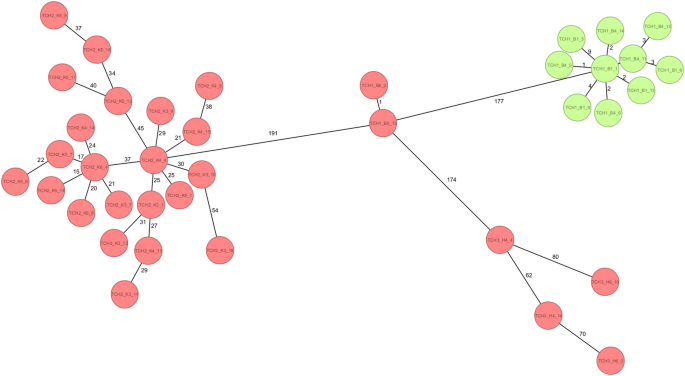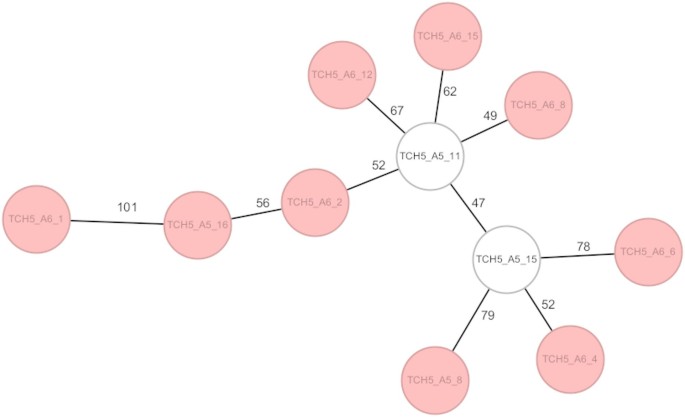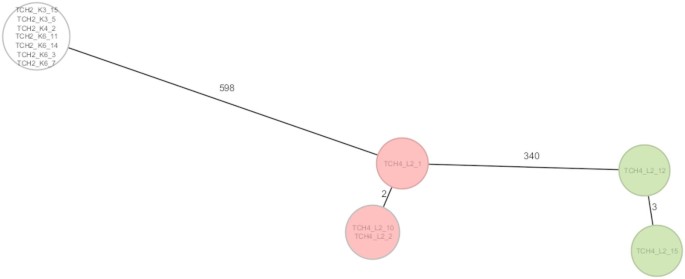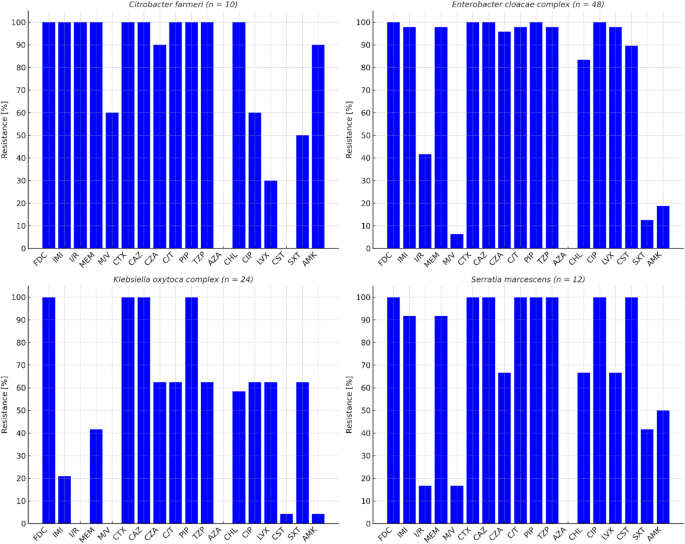Cefiderocol-resistant bacteria in wastewater: occurrence and resistance profiles
Cefiderocol-resistant bacteria were identified in 50% of wastewater samples (18/36), with detection rates varying significantly by location: from 16.7% (1/6 samples) at TCH6 to 66.7% (4/6 samples) at TCH1 and TCH2. A total of 97 cefiderocol-resistant isolates were recovered and identified, with the most prevalent species being E. roggenkampii (n = 44), K. oxytoca (n = 16), S. marcescens (n = 12), C. farmeri (n = 10), and K. michiganensis (n = 8). Additional species were identified in smaller numbers, including Enterobacter asburiae (n = 3), Enterobacter soli (n = 1), Myroides odoratus (n = 1), K. pneumoniae (n = 1), and Elizabethkingia anopheles (n = 1). Most isolates exhibited high MICs against cefiderocol, with 80 out of 97 isolates showing MICs ≥ 32 mg/L, 15 with MICs of 16 mg/L, and only two isolates—K. pneumoniae and E. anopheles—displaying MICs of 4 mg/L.
All isolates were resistant to ureidopenicillins (e.g. piperacillin) and cephalosporins (e.g. cefotaxime, ceftazidime), whereas slightly lower resistance rates—ranging from 83.5–89.7%—were observed for β-lactam/β-lactamase inhibitor combinations, such as piperacillin-tazobactam, ceftolozane-tazobactam, and ceftazidime-avibactam (Fig. 1). Resistance to carbapenems was notably high, with rates of 77.3% for imipenem and 82.5% for meropenem. However, the combination of carbapenems with β-lactamase inhibitors significantly reduced resistance, with rates dropping to 32.9% for imipenem-relebactam and 10.1% for meropenem-vaborbactam. Importantly, all isolates were fully susceptible to aztreonam-avibactam.
Phenotypic antimicrobial resistance detected in cefiderocol-resistant isolates of Citrobacter farmeri (n = 10), Enterobacter cloacae complexa (n = 48), Klebsiella oxytoca complexb (n = 24), and Serratia marcescens (n = 12). Abbreviations: FDC (cefiderocol), IMI (imipenem), I/R (imipenem-relebactam), MEM (meropenem), M/V (meropenem-voborbactam), CTX (cefotaxime), CAZ (ceftazidime), CZA (ceftazidime-avibactam), C/T (ceftolozane-tazobactam), PIP (piperacillin), TZP (piperacillin-tazobactam), AZA (aztreonam-avibactam), CHL (chloramphenicol), CIP (ciprofloxacin), LVX (levofloxacin), CST (colistin), SXT (sulfamethoxazole-trimethoprim), AMK (amikacin). (a) consisting of E. roggenkampii (n = 44), Enterobacter asburiae (n = 3), and Enterobacter soli (n = 1). (b) consisting of K. oxytoca (n = 16) and Klebsiella michiganensis (n = 8).
Amikacin and trimethoprim-sulfamethoxazole exhibited comparatively lower resistance rates of 28.9% and 32.0%, respectively. In contrast, resistance to fluoroquinolones remained high, with rates of 86.6% for ciprofloxacin and 77.3% for levofloxacin. Resistance rates for chloramphenicol and colistin were also substantial, recorded at 75.3% and 59.8%, respectively.
Notably, three isolates from TCH1, TCH2, and TCH5—identified as E. roggenkampii, S. marcescens, and E. asburiae—were classified as PDR, exhibiting resistance to cefiderocol and the following tested antimicrobials: TZP, CTX, CAZ, CZA, C/T, IMI, MEM, AMK, CIP, LVX, SXT, ATM, CHL, and CST. However, these isolates remained susceptible to newer agents such as aztreonam-avibactam, although E. roggenkampii exhibited resistance to imipenem-relebactam and E. asburiae was resistant to meropenem-vaborbactam.
Furthermore, eleven K. oxytoca isolates from TCH5 and one C. farmeri isolate from TCH1 were classified as XDR, displaying susceptibility to amikacin and colistin. An E. asburiae isolate from TCH5 was also classified as XDR, showing susceptibility to aztreonam. Notably, all of these isolates were sensitive to the newer agents aztreonam-avibactam, imipenem-relebactam, and meropenem-vaborbactam.
Clonal distribution and sequence types across hospital sites
From the 97 recovered isolates, 79 were selected for detailed characterization via WGS. Selection criteria included representing diverse phenotypic profiles, ensuring coverage of all sampling points to maximize temporal variability, and minimizing redundancy by excluding potential clonal isolates. The latter was particularly important to address possible biases introduced by pre-enrichment procedures during selective isolation from wastewater.
At TCH1, all C. farmeri isolates (n = 7) were identified as belonging to sequence type (ST) 857. Clonal distributions of E. roggenkampii varied by site. At TCH1, a minority of isolates belonged to ST165 (16.7%, n = 2/12), while the majority (83.3%, n = 10/12) were non-typeable due to a nucleotide change in the rplB locus. cgMLST provided deeper insights into genetic relationships, confirming that the two ST165 isolates were clonal, differing by just one allele. In contrast, the E. roggenkampii isolates, representing a novel MLST type, differed from ST165 by 177 alleles and formed a distinct cluster with 1–9 allelic differences among themselves (Fig. 2). In comparison, TCH2 and TCH3 displayed greater clonal homogeneity, with all isolates at both sites belonging to ST165 (n = 22 in TCH2, n = 4 in TCH3). All E. roggenkampii isolates from TCH2 and TCH3 belonged to ST165 but showed substantial cgMLST allelic differences compared to the ST165 isolates from TCH1, highlighting the genetic diversity not captured by MLST.

Minimum-spanning tree of Enterobacter roggenkampii (n = 38) based on cgMLST analysis (2,466 loci). Each circle represents an individual isolate; numbers on connecting lines indicate allelic differences. Red-filled circles denote isolates belonging to ST165, while green-filled circles represent isolates assigned to a novel sequence type.
At TCH5, isolates from the Klebsiella oxytoca complex were predominantly identified as K. oxytoca ST2 (81.8%, n = 9/11). Two isolates were non-typeable using the classical MLST scheme based on seven housekeeping genes due to a single nucleotide change in the phoE locus. While the majority of isolates belonged to ST2, cgMLST revealed allelic differences ranging from 47 to 101, indicating notable genetic diversity within this sequence type and suggesting the presence of distinct sublineages (Fig. 3). In contrast, all isolates from TCH4 (n = 8) were identified as K. michiganensis ST35.

Minimum-spanning tree of Klebsiella oxytoca (n = 11) isolates from TCH5 based on cgMLST (2,538 loci). Each circle represents an individual isolate; numbers on connecting lines indicate allelic differences. Red-filled circles indicate isolates belonging to ST2, while unfilled (colorless) circles represent isolates assigned to a novel sequence type.
Serratia marcescens isolates from TCH2 (n = 7) were entirely non-typeable by MLST, potentially indicating novel or uncharacterized lineages. cgMLST analysis further supported this notion, as the TCH2 isolates formed a distinct cluster with at least 598 allelic differences from the TCH4 isolates, suggesting a genetically separate lineage (Fig. 4). Conversely, S. marcescens isolates from TCH4 exhibited greater genetic diversity. MLST assigned 40% (n = 2/5) of the isolates to ST473 and another 40% to ST731, while one isolate remained non-typeable. However, cgMLST provided a more detailed resolution, revealing allelic differences ranging from 2 to 340 among the TCH4 isolates. While some formed closely related clusters (≤ 3 allelic differences), others showed substantial divergence, further emphasizing the ability of cgMLST to resolve genetic relationships at a much finer scale than classical MLST.

Minimum-spanning tree of Serratia marcescens (n = 12) based on cgMLST (2,682 loci). Each circle represents an individual isolate; numbers on connecting lines indicate allelic differences. Red-filled circles indicate isolates belonging to ST473, green-filled circles represent ST731, and unfilled (colorless) circles correspond to isolates assigned to novel sequence types.
Antimicrobial resistance genes and multi-drug potential
We identified distinct ARG profiles among the recovered cefiderocol-resistant bacterial species, with a notable prevalence of β-lactamase and carbapenemase genes. The detected ARGs and their combinations are summarized in Supplementary Table S1. In brief, and focusing solely on carbapenemase genes: C. farmeri (7/7) carried blaNDM−1 alone (n = 3) or in combination with blaOXA−48 (n = 4); E. roggenkampii (30/38) harbored either blaNDM−1 (n = 16) or blaVIM−1 (n = 14); all K. oxytoca isolates (11/11) co-carried blaOXA−48 and blaVIM−1; and S. marcescens (12/12) predominantly encoded blaKPC−2 (n = 9), with additional isolates carrying blaVIM−1 either alone (n = 1) or in combination with blaOXA (n = 2). A detailed overview of the full resistome follows in the species-specific sections below.
C. farmeri (n = 7) displayed the most diverse genotypic resistance profile among the species, with ARG counts ranging from 6 to 22 per isolate. Prominent β-lactamase genes, including blaSHV−12, blaTEM−1, and blaCTX−M−15, were frequently identified, underscoring resistance across multiple β-lactams. Notably, one isolate from TCH1 harboured six distinct β-lactamase genes: blaOXA−9, blaTEM−1, blaNDM−1, blaCTX−M−15, blaOXA−1, and blaSHV−12. Beyond β -lactams, resistance was observed in quinolones (qnrS1), phenicols (catB3), macrolides (mph(A)) and aminoglycosides (e.g., aac(6’)-Ib, aadA1 and rmtC).
Enterobacter roggenkampii (n = 38) isolates showed ARG counts from 4 to 19 per isolate, with β-lactam resistance largely attributed to blaTEM−1 and blaCTX−M−15, supporting broad resistance across β-lactams, including extended-spectrum cephalosporins. Significant ARGs outside of β-lactams included aac(6’)-Ib for aminoglycosides, qnrB1 and qnrB2 for quinolones, catB3 for phenicols, sul1 and sul2 for sulfonamides, and tet(A) for tetracyclines. In the two E. asburiae isolates, 9 and 14 ARGs were identified, with carbapenemase genes blaNDM−1 and blaVIM−1 each present in separate isolates. Key β-lactamase genes in this species included blaACT−2 and blaOXA−1, contributing to resistance against cephalosporins. Additional ARGs included aac(6’)-Ib4 and aadA1 for aminoglycosides, qnrB1 and qnrS1 for quinolones, catA1 for phenicols, sul1 for sulfonamides, and tet(A) for tetracyclines.
In the K. oxytoca complex (n = 19), ARG counts ranged from 7 to 17 per isolate. Relevant ARGs included aac(6’)-IIc, aadA1, aph(3’’)-Ib, aph(3’)-Ia, aph(6)-Id (aminoglycosides), qnrS1 (quinolones), catA1 (phenicols), sul1 (sulfonamides), dfrA1 (trimethoprim) and tet(A) (tetracyclines). Interestingly, all K. michiganensis isolates from TCH4 (n = 8) lacked carbapenemase-encoding genes. Six of these isolates displayed phenotypic susceptibility to ceftazidime-avibactam, imipenem, and meropenem, while all were resistant to cefiderocol. These isolates carried blaSHV−12 in combination with emrD, encoding a multidrug efflux pump.
Serratia marcescens (n = 12) exhibited one of the broadest ranges of ARGs, with counts ranging from 11 to 20 per isolate, highlighting its exceptionally high multidrug resistance potential. The presence of β-lactamase genes, including blaTEM−1, blaSHV−12, blaOXA−1, blaOXA−2, blaACC−1, blaSRT, blaCTX−M−9 and blaCTX−M−15, contributed extensively to β-lactam resistance. Further resistance mechanisms involved aac(6’), aac(6’)-Ib, aac(6’)-Ib4, aadA1, aph(3’’)-Ib, aph(6)-Id for aminoglycosides, qnrB1 for quinolones, catA1 for phenicols, sul1 for sulfonamides, and tet(41) for tetracyclines, establishing S. marcescens as highly resistant across multiple antibiotic classes. Of particular importance is the presence of multiple efflux pump-encoding genes, including sdeB, sdeY, and smfY.
Resistance to biocides and heavy metals
The analysis of resistance gene profiles revealed significant biocide and heavy metal resistance across bacterial isolates, underscoring their adaptability to environmental and anthropogenic stressors. The most prevalent biocide resistance gene, qacEdelta1, was detected in 63.3% (n = 50/79) of isolates, including C. farmeri, E. roggenkampii, K. oxytoca, and S. marcescens, indicating widespread resistance to quaternary ammonium compounds commonly used in disinfectants. qacE was found in 24.0% (n = 19/79) of isolates and frequently co-occurred with qacEdelta1, suggesting potential synergistic effects that enhance resistance. Notably, S. marcescens exhibited the highest diversity of biocide resistance genes, with up to six distinct genes per isolate, while E. roggenkampii consistently carried qacEdelta1 and qacE, further highlighting species-specific adaptations to biocidal agents.
Heavy metal resistance was similarly widespread, with the genes silA, arsC, and fief identified in 97.5% (n = 77/79) of isolates, reflecting robust resistance to silver and arsenic. Complementary genes, such as silR and silP, were present in 83.5% (n = 66/79) of isolates. K. oxytoca complex isolates harboured the highest number of metal resistance genes, averaging 26.7 genes per isolate, followed by E. roggenkampii (20.1 genes) and C. farmeri (18.6 genes). S. marcescens displayed lower averages (7.8 genes) but still demonstrated notable variability. Species-specific patterns emerged, with sil and ars genes prevalent in C. farmeri and Enterobacter species, while K. oxytoca complex and S. marcescens exhibited similar profiles. Mercury resistance genes, such as merE and merB, were sporadically detected, adding a layer of defence in isolates with broader resistance capabilities. These findings underscore the resilience of bacterial communities in biocide- and metal-stressed environments, highlighting the potential challenges in healthcare and environmental settings where these selective pressures are prevalent.
Virulence mechanisms: intrinsic and acquired factors
This study identified a wide range of virulence factors across bacterial isolates. Notably, the acquired factor clpV was detected in eight K. michiganensis isolates from TCH4. In contrast, none of the Klebsiella isolates exhibited the virulence-associated factors yersiniabactin (YbST), colibactin (CbST), aerobactin (AbST), or salmochelin (SmST), nor the regulatory genes rmpA and rmpA2 (RmpADC) linked to the hypermucoid phenotype and enhanced capsule production.
However, intrinsic factors were prevalent across the investigated isolates, with rcsB (78 isolates) playing a key role in immune modulation and biofilm formation, and ompA (66 isolates) contributing to immune evasion and host cell adhesion. Key iron acquisition genes such as entB and fepC (66 isolates each) enhance survival in iron-limited environments, while fliC supports motility and tissue invasion. Additional factors contribute to adherence, antimicrobial activity, biofilm formation, effector delivery, invasion, and regulation, providing a comprehensive virulence toolkit. Notably, the absence of tolC renders the AcrAB-TolC efflux pump incomplete, potentially diminishing its role in resistance and virulence.
Plasmid diversity and incompatibility types
Our analysis revealed notable variation in plasmid loads among species. C. farmeri exhibited the highest average plasmid load (56 plasmid incompatibility (Inc) types across seven isolates), followed by the K. oxytoca complex (137 Inc types across 19 isolates). Serratia marcescens and E. roggenkampii carried moderate loads, with 78 plasmid Inc types across 12 isolates and 199 plasmid Inc types across 38 isolates, respectively.
Across species, 38 unique plasmid Inc types were identified, with all detected Inc types listed in Supplementary Table S2. Of these, 18 were exclusive to a single species, indicating potential species-specific associations. Notable exclusive types included Col(IMGS31) in C. farmeri, IncFIB(pECLA) in E. roggenkampii, and IncFIB(pKPHS1) in K. oxytoca.
In contrast, 20 plasmid Inc types appeared across multiple species, suggesting their potential to facilitate gene transfer and adaptation across genera. ColRNAI, found in C. farmeri, E. roggenkampii, K. oxytoca, and S. marcescens, and Col440II, primarily associated with E. roggenkampii but also found in C. farmeri and S. marcescens, highlight adaptability and likely involvement in interspecies gene transfer.
Plasmids IncHI2A and IncHI2 were also present across multiple species, known for their association with antimicrobial and metal resistance, enhancing bacterial survival in challenging environments. Col440I was prevalent in E. roggenkampii and also appeared in K. oxytoca and S. marcescens, reflecting adaptability across genera.
Conversely, IncFIB(pECLA) and IncFII(pECLA) were exclusive to E. roggenkampii, indicating possible species-specific roles in resistance. IncFIB(K), primarily in K. oxytoca with occasional presence in S. marcescens, is strongly associated with Klebsiella but exhibits cross-genera adaptability.
Finally, IncX3 showed broad distribution across E. asburiae, E. roggenkampii, K. oxytoca, and S. marcescens, underscoring its versatility.
Detailed information on the phenotypic and genotypic characteristics of each isolate, along with its isolation source and date, is provided in Supplementary Table S3.
